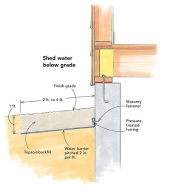Klaus,
I would recommend sticking with a somewhat traditional septic. If properly sized, they last a lifetime with no maintenance. I used a septic for 20 years, opened the tank for inspection, and there was only a few inches of semi-solid waste on the bottom. The rest was fluid. Some places around here, because the soil is mostly sand and drains so well, you can place the drain field where the top of it is 6 inches below the surface to minimize digging. I would recommend, as mentioned above, that you install your drain field pipe horizontally to the slope. Within a week or two the bacteria in the tank with establish itself and any smell from a vent will be gone.
Your biggest problem is going to be toilet paper, if you use it. You will need to use something that is easily biodegradable. Otherwise it will take a very long time to break down and will float on the surface in the tank depriving some of the bacteria of oxygen. Here in the USA some toilet paper is labeled "Septic Safe" and deteriorates much more quickly. If you studied traditional septics, you know the input and output are near the top of the tank, with a partial wall between them that extends down from the top to below the output level. This is so that paper and other floating items don't get into your drain field and plug it up. Alternatively, you can have your output pipe bend down a foot or so below the input level. Around here, they go one step further and put a T on the tank side of the output pipe, where one side of the T points down for waste fluid to enter, and the other side sticks above the output so that you can clean it. Then the vertical part of the T is filled with a plastic mesh that is removed once a year and washed out. This will prevent it from getting clogged if the level should ever drop below the output and solid waste reaches the output pipe.
For drainfield you can use any pipe with lots of holes in the bottom and sides, surrounded with at least 6 inches of stone or other material that doesn't pack hard, and wrap the whole thing (stones and pipe) in landscape fabric to keep dirt from washing into and filling up your drainfield. I would think the forest floor would be very porous and be able to absorb a lot of liquid. Even bath water contains feces, so you need to be sure everything is underground to keep people, animals, fruits and vegetables and erosion from your output. Never allow wastewater to come in contact with the edible parts of plants, and wait a month after applying waste water to the roots of plants before eating any part of them.
It seems to me, the solution you are considering can't be used with toilet paper, which may or may not be a consideration in your case. And is much more fragile than a traditional system. What happens if someone flushes some bleach down your toilet that kills all the worms? How fast does the mulch in your tank need to be replenished? Traditional septics will reestablish themselves after a catastrophe in a few weeks with no intervention. Best of luck!









